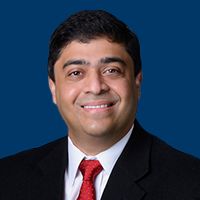Article
Continued Emergence of Targeted Therapies Reinforces Need for Frequent Genetic Testing in NSCLC
Author(s):
Although the efficacy of targeted agents and outcomes for patients with genetic mutations can vary, the availability of these treatments adds to the need for genetic testing across all patients with non–small cell lung cancer.
David Gerber, MD

The development of targeted therapies for non–small cell lung cancer (NSCLC) continues to expand. Although the efficacy of targeted agents and outcomes for patients with genetic mutations can vary, the availability of these treatments adds to the need for genetic testing across all patients with NSCLC, according to faculty from an OncLive® State of the Science Summit™ on lung cancer.
The event, chaired by David Gerber, MD, faculty member in the Hematology Oncology Division, associate director for Clinical Research, the Harold C. Simmons Comprehensive Cancer Center, co-leader of the Experimental Therapeutics Program, UT Southwestern Harold C. Simmons Comprehensive Cancer Center, highlighted updates across the lung cancer landscape, including the use of immunotherapy in NSCLC, targeted therapies beyond EGFR inhibitors in NSCLC, updates in the management of small cell lung cancer (SCLC), and advances in radiation therapy.
Gerber was joined by his colleagues:
- Jonathan Dowell, MD, professor, Program Director, Hematology Oncology Fellowship Program, UT Southwestern Harold C. Simmons Comprehensive Cancer Center
- Sheena Bhalla, MD, assistant professor, Department of Internal Medicine, UT Southwestern Harold C. Simmons Comprehensive Cancer Center
- Benjamin Drapkin, MD, PhD, assistant professor, Department of Internal Medicine, UT Southwestern Harold C. Simmons Comprehensive Cancer Center
- Puneeth Iyengar, MD, PhD, associate professor, chief, Lung Radiation Oncology Service, UT Southwestern Harold C. Simmons Comprehensive Cancer Center
Below, Dowell, Bhalla, Drapkin, Iyengar, and Gerber summarize the main messages from their presentations.
Questions Surrounding the Identification of Ideal Patients for Neoadjuvant/Adjuvant Chemoimmunotherapy In NSCLC
Dowell: There are many unanswered questions [surrounding the use of neoadjuvant and adjuvant immunotherapy in patients with NSCLC]. Who should receive neoadjuvant chemoimmunotherapy? Do we think a 3.5 cm node-negative tumor needs neoadjuvant therapy? I don’t know. Is 3 cycles [of chemoimmunotherapy] enough? I don’t know the answer. If it was active, would more be better?
Is neoadjuvant or adjuvant chemoimmunotherapy preferable? There are some proposed trials that may evaluate that question, but they will be long, arduous trials to conduct, and we won’t get results for a long time. If we employ neoadjuvant therapy, what about the patients who don’t respond well? It is important to know if they need more therapy.
What about the patients who have a great response and have no [residual disease]? Do they need surgery? That’s provocative, but we don’t know the answer.
Targeted Therapies Offer Varying Efficacy in NSCLC, Though Frequent Testing Is Still Needed
Gerber: Not all molecular targets result from [gene] mutations. There are other things that can happen to the gene. That’s important for selection of next-generation sequencing [NGS], because if you include RNA sequencing, you are more likely to identify some of these fusions and the MET mutation.
When it comes to KRAS G12C inhibitors, they have relatively modest efficacy, and that is why they are approved only for second-line treatment. Unlike the other targeted therapies, clinicians have to give patients chemotherapy and immunotherapy before you give the KRAS inhibitor.
What about ALK inhibitors, which are far more effective? Among all the [ALK inhibitors], there are meaningful differences in their efficacy, how much they penetrate the blood-brain barrier, what resistance mutations they work against, and their toxicity.
Regarding RET inhibitors, they have moderate efficacy, but there are toxicities of hypertension, hepatotoxicity, bleeding, and QT prolongation.
Regarding MET inhibitors, they have disappointing efficacy compared with other targeted therapies. Moreover, it is important to watch for edema [with MET inhibitors].
In general, it is reasonable to repeat molecular testing—whether that is blood based or a [tissue] biopsy—at the time of resistance to look for secondary mutations or histologic transformation, with the latter only found with tissue analysis so far.
My final point is that contemporary use of targeted therapy for NSCLC is tricky. Clinicians need a clear understanding of molecular diagnostics, must monitor and manage toxicities, and need to anticipate the potential for limited efficacy, despite all the [excitement of targeted therapies].
Developments Continue in EGFR-Mutated NSCLC
Bhalla: The progress in EGFR-positive NSCLC is phenomenal. It speaks to the patients who participate in clinical trials and the resilience of clinical researchers.
One takeaway for everybody is we have to look [for these mutations]. Broad NGS testing [is important] in these patients to find both classical EGFR mutations, as well as exon 20 insertion mutations that now have [targeted] treatments.
Updates in the Management of SCLC
Drapkin: For carefully selected [patients with] SCLC, they can be candidates for surgery, provided they get adjuvant therapy. Thoracic radiation regimens for SCLC are evolving with dose intensification and the addition of immune checkpoint inhibitors.
The role for whole brain radiation for treatment or prophylaxis is unclear in the era of MRI surveillance and stereotactic radiosurgery. We need a biomarker for chemoimmunotherapy, and we need a way to extend its benefit beyond the 10% to 15% of patients [who benefit from anti–PD-L1 therapy]. Finally, the long-term role for lurbinectedin [Zepzelca] in relapsed SCLC is unclear.
Combination Immunotherapy and Radiation in NSCLC
Iyengar: For stage III NSCLC, the sky is the limit with immunotherapy combined with radiation and chemotherapy. We’ve shown that in the adjuvant setting, [immunotherapy plus chemotherapy and radiation] is extremely beneficial over a prolonged period. We’re seeing 5-year survivors like we’ve never seen before with this patient population. Hopefully we will see an even greater synergy between radiation and immunotherapy when given concurrently in the adjuvant setting.
In the setting of stage IV disease, we must let some of these studies pan out. However, we hope that we will have another treatment modality in our toolkit to be able to improve survival for this patient population.
We need to do more biologic work to understand the synergy between radiation and immunotherapy, the synergy of timing, and the synergy of sequencing. However, there is enough of a signal to hope that there’s a synergistic benefit [there].








